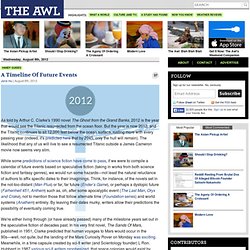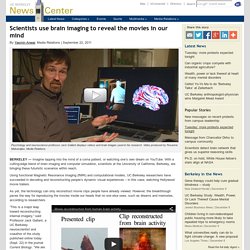

A Timeline Of Future Events. As told by Arthur C.

Clarke's 1990 novel The Ghost from the Grand Banks, 2012 is the year that would see the Titanic resurrected from the ocean floor. But the year is now 2012, and the Titanic continues to sit 12,000 feet below the ocean surface, rusting more with every passing year (indeed, it's predicted here that by 2045, only the hull will remain). The likelihood that any of us will live to see a resurrected Titanic outside a James Cameron movie now seems very slim. We're either living through (or have already passed) many of the milestone years set out in the speculative fiction of decades past. In his very first novel, The Sands Of Mars, published in 1951, Clarke predicted that human voyages to Mars would occur in the 90s—well, not quite, but the landing of the Mars Curiosity Rover on Monday was exciting. While some speculative fiction aims to depict utopias, more often their future worlds are downright terrifying—heavy literalizations of current social capitalist fears.
Scientists use brain imaging to reveal the movies in our mind. BERKELEY — Imagine tapping into the mind of a coma patient, or watching one’s own dream on YouTube.

With a cutting-edge blend of brain imaging and computer simulation, scientists at the University of California, Berkeley, are bringing these futuristic scenarios within reach. Using functional Magnetic Resonance Imaging (fMRI) and computational models, UC Berkeley researchers have succeeded in decoding and reconstructing people’s dynamic visual experiences – in this case, watching Hollywood movie trailers. As yet, the technology can only reconstruct movie clips people have already viewed. However, the breakthrough paves the way for reproducing the movies inside our heads that no one else sees, such as dreams and memories, according to researchers. The approximate reconstruction (right) of a movie clip (left) is achieved through brain imaging and computer simulation Brain activity evoked by the second set of clips was used to test the movie reconstruction algorithm. Reconstructing visual experiences from brain activity evoked by natural movies. - GallantLabUCB.
Study of the Day: Soon Enough, You May Be Able to DVR Your Dreams - Hans Villarica - Life. New research reconstructs people's memories of Hollywood movie trailers and paves the way for recording our unconscious thoughts PROBLEM: Though everyone dreams, very few remember in detail the world they drifted to while they were unconscious.

Similarly, what goes on in the minds of people who cannot communicate, such as stroke victims, coma patients, and people with neurodegenerative diseases, is a mystery. METHODOLOGY: Three members of the University of California, Berkeley research team served as the subjects of the experiment. They remained still inside a Magnetic Resonance Imaging (MRI) scanner for hours at a time while watching two separate sets of Hollywood movie trailers. Functional MRI was used to measure blood flow through the visual cortex, the part of the brain that processes visual information. While participants viewed the first set of videos, a computer program learned, second by second, to associate visual patterns in the movie with the corresponding brain activity.